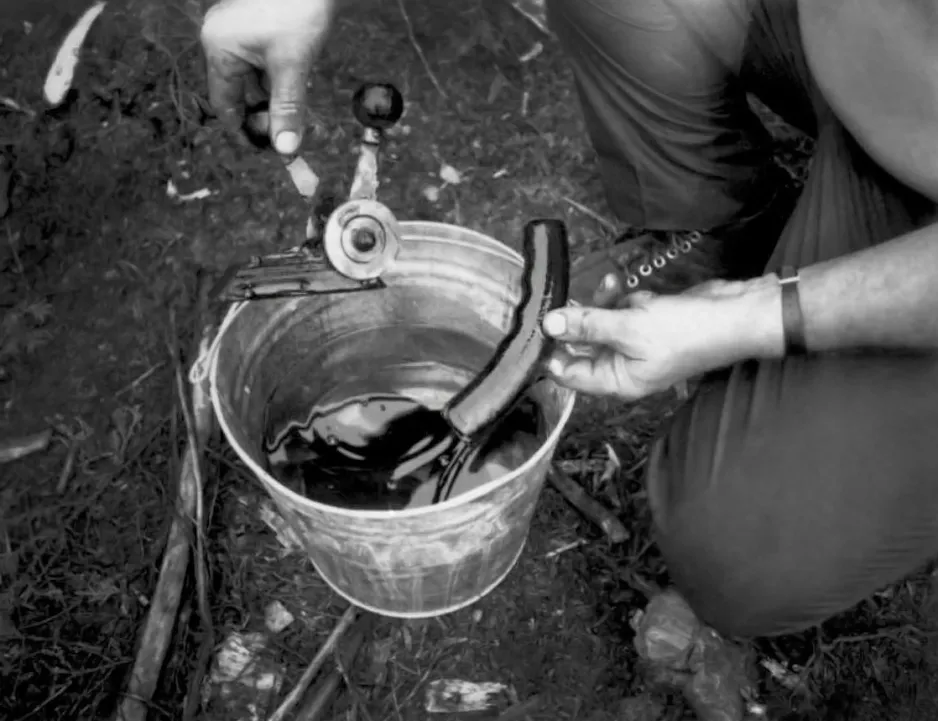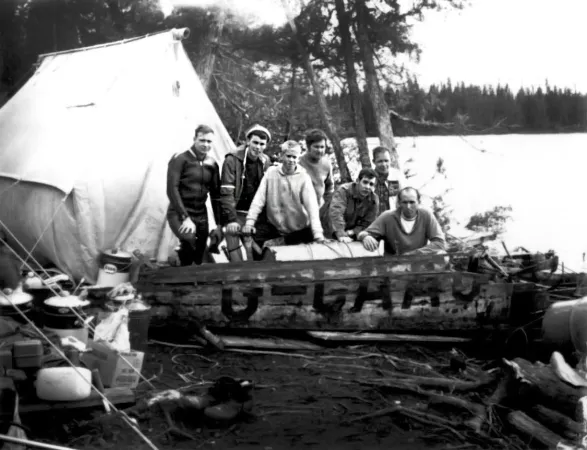Saving the Curtiss HS-2L: Recovering a piece of history from the bottom of a lake
If artifacts could talk, they would have some fascinating stories to tell. This is certainly true for the Curtiss HS-2L La Vigilance — proudly displayed at the Canada Aviation and Space Museum in Ottawa — which happens to be the only complete Curtiss HS-2L left in the world.
A short history
Ingenium’s Curtiss HS-2L was a flying boat aircraft that was used by the U.S. Navy for anti-submarine patrols during the last two years of the First World War. Twelve Curtiss HS-2L aircraft were sold by the U.S. Navy to Canada after the war, and the Curtiss HS-2L became the first bush aircraft used in Canada. It was ideal for use in the remote areas of Canada, because there is an abundance of lakes; as a flying boat aircraft, the Curtiss HS-2L can land and take off from water. They were used for forestry patrols, timber and mining surveys, and even delivered air mail to northern communities. During this era of aviation, aircraft were still somewhat unreliable and crashed often, or were scavenged for parts to build new aircraft.

Tail sections of the original (1969.1330) and reconstructed Curtiss HS-2L (1975.0754), showing the call letters G-CAAC.
A watery resting place
On September 2, 1922, a Curtiss HS-2L called La Vigilance crashed into Foss Lake, Ontario. While the pilot survived, La Vigilance remained at the bottom of the lake until 1967, when the location of the wreck was reported. The hull, along with metal parts and fittings from the aircraft, was retrieved by the National Aviation Museum (now the Canada Aviation and Space Museum) during a salvage operation between 1968 and 1969. Today, you can see that hull — which sat underwater for nearly 50 years — beside the plane in the museum. La Vigilance is a reconstruction that uses parts from that salvaged plane and two other Curtiss HS-2L planes. La Vigilance has the call letters G-CAAC, which were the registration call letters of the first plane owned by Laurentide Air Service Limited; if you look closely you may be able to make out those same letters on the side of the salvaged hull.

Tail sections of the original (1969.1330) and reconstructed Curtiss HS-2L (1975.0754), showing the call letters G-CAAC.
The conservation effort
Following the successful salvage operation, the museum staff had to come up with a way to conserve the rescued sections of the waterlogged plane. When submerged in water for long periods of time, wood cells are weakened; the cells are often attacked by microbes that live in the water and weaken the wood through natural decomposition. When a large piece of wood that is saturated with water is removed from the water, it does not always dry at an even rate — resulting in warping and cracking. So, removing a plane with a wooden body from a lake after 46 years becomes a tricky task. However, the rarity and specific provenance of this plane made it a desirable object for the Ingenium collection, so the museum had to figure out a way to save it.
At the time of the aircraft’s initial treatment in the 1960s, there was very little literature available on how to treat waterlogged wood. The curator at that time, Robert W. Bradford, found an article in the January 1962 edition of National Geographic describing a new treatment for waterlogged wood that was being performed on a gigantic Swedish warship, the Vasa, which was built in 1626. The Vasa was one of the first and largest waterlogged wooden objects treated with a substance called Polyethylene glycol (PEG) in 1961. Shortly thereafter, a similar PEG treatment was performed on Ingenium’s Curtiss HS-2L in 1968.

A member of the salvage crew brushes PEG onto the side of the salvaged hull.
Treatment with PEG, a synthetic resin, is now recognized as a common conservation treatment for waterlogged wood. The substance PEG is a bulking agent that penetrates the cell walls and replaces the water, providing structure inside the cell walls as the wood dries, therefore holding the original shape of the wood and avoiding major structural changes. However, PEG also makes the object heavier and gives it a bit of a waxy appearance. Like all modern conservation treatments, PEG is intended to be reversible. For example, PEG is soluble in water and other solvents, but should never be fully removed to avoid structural damage. The team that salvaged the Curtiss HS-2L saved the artifact by applying PEG.

During the salvage operation, smaller objects were dipped into PEG inside a bucket.
The Curtiss HS-2L was first treated with PEG (Carbowax 1540) at the excavation site in the bush of northern Ontario. The museum staff heated up a 50-50 solution of PEG and water on camp stoves, then brushed or dipped the pieces to coat them with PEG right at the side of the lake.
After the pieces were treated and dried, they were flown by helicopter and air freight to the National Aviation Museum. Upon arrival, the pieces of the Curtiss HS-2L were given a second treatment of PEG. Museum records are vague on the rational for this approach, but it is believed that the pieces of wood looked dry — which is now recognized as evidence of a successful treatment. Applications of PEG were very new in the 1960s, so, they opted for a second coat of PEG, perhaps just to “be safe.” Unfortunately, the secondary application of PEG was unable to fully soak into the wood and resulted in pooling on low areas of the hull, large drips, and an overall lumpy and uneven appearance.

A layer of dust covers the interior of the HS-2L hull, on display in the Bush Flying exhibition at the
Canada Aviation and Space Museum.
Preventative conservation
Conservators are tasked with addressing many aspects of artifact and collection health, including maintaining a stable climate — which is one of the easiest ways to prolong an artifact’s life. Incorrect or fluctuating relative humidity (RH) is one of the most damaging external factors that can affect an artifact. Rapid changes in RH can cause changes in the shape and stability of an artifact, and cause softening or stiffening of materials as they approach melting and freezing points. If the RH is too low materials can crack, stiffen and become brittle, and if the RH is too high (over 60 per cent) mold growth can occur, and there is an increased risk of corrosion. A rapid change in RH, like when the large hangar doors are opened to move aircraft in the summer, may also have the same effects on the materials used to preserve objects; such is the case with the PEG on the Curtiss HS-2L.
Controlling the space around an object — rather than treating the object itself — is a very simple description of preventative conservation. Generally, this is a successful way of prolonging the life of artifacts, and it takes a large team of people to do this successfully. Ingenium has fantastic conservation, facility management, and building operation teams who work together to maintain a stable museum environment. Due to the size of the objects on display at the Canada Aviation and Space Museum, they can only be moved during the summer months. This involves opening up the hangar doors and letting in the, often hot and humid, outside weather. So, when objects are moved in the summer it takes the interior of the building a little while to adjust back to its standard relative humidity and temperature. In the summer months, the air is kept cool and dry with the use of large air conditioning units. In the winter months — when the RH of the building can reach just 10 per cent — moisture and heat are added back into the air. Ottawa experiences 60–80-degree annual seasonal temperature swings; our building operators work hard to meet the artifacts needs.
It is important to remember that PEG is soluble in water. If the RH in the museum rises above 60 per cent, the PEG on the exterior of the Curtiss HS-2L beings to soften, becomes sticky, and occasionally drips off of the hull (when the temperature in the museum rises above the standard 18-20 degrees Celsius). It is hard to accurately measure the exact temperature at which the PEG begins to soften, because exposure to sunlight and oxygen have partially degraded the PEG, affecting its stability. The hull of the Curtiss HS-2L naturally collects dust from being on open display, and in the warm, humid summer months, that dust becomes stuck onto the surface of the hull and cannot be removed with a duster, or a cloth during regular exhibition maintenance. Aside from being unsightly, dust attracts pests, and on a microscopic level, holds water vapor close to the surface of the hull.
It is sometimes difficult to predict how an artifact is going to react in a certain climate no matter how much research is done before it is put on display. The hull of the Curtiss HS-2L was saved by the application of PEG received after it was salvaged. There was no way that team could have predicted the hot, sticky summers of the future that caused the PEG to attract so much dust. Conservation is a field of applied arts and sciences that is constantly adapting and evolving to meet the needs of the objects humans deem worthy of collection, documentation, and preservation. Currently, after assessing the condition of the Curtiss HS-2L, the Ingenium team is in the process of designing a treatment plan for the hull to remove the excess PEG and reduce the dust. The basic goals of the treatment are to improve the appearance of the Curtiss HS-2L, to create an easier surface for regular maintenance and, most importantly, to be able to improve the overall stability of the artifact. Ultimately, this treatment and the efforts of the Ingenium team will lengthen the life of this significant artifact.
Go further
https://www.ingeniumcanada.org/sites/default/files/doc/research/casm/e_HS-2L.pdf









![A block of photographs showing some of the people involved in the bombing of beluga whales in the estuary and gulf of the St. Lawrence River. Anon., “La chasse aux marsouins [sic]. » Le Devoir, 15 August 1929, 6.](/sites/default/files/styles/thumbnail_7/public/2024-09/Le%20Devoir%2015%20aout%201929%20page%206.jpg?h=584f1d27&itok=TppdLItg)






